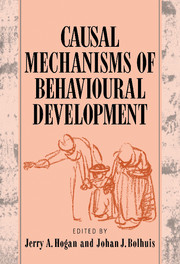Book contents
- Frontmatter
- Contents
- List of contributors
- Foreword: Introducing Jaap Kruijt
- Preface
- Part one Introduction
- Part two Development of perceptual and motor mechanisms
- Part three Development of behaviour systems
- Part four Development of cognition
- 11 Cortical mechanisms of cognitive development
- 12 Cognitive development in animals
- 13 The biological building blocks of spoken language
- Part five Learning and development
- Author index
- Subject index
11 - Cortical mechanisms of cognitive development
Published online by Cambridge University Press: 19 January 2010
- Frontmatter
- Contents
- List of contributors
- Foreword: Introducing Jaap Kruijt
- Preface
- Part one Introduction
- Part two Development of perceptual and motor mechanisms
- Part three Development of behaviour systems
- Part four Development of cognition
- 11 Cortical mechanisms of cognitive development
- 12 Cognitive development in animals
- 13 The biological building blocks of spoken language
- Part five Learning and development
- Author index
- Subject index
Summary
Introduction
The region of the primate brain which shows the greatest extent of postnatal development is the cerebral cortex, with detectable changes occurring within the region in humans until the teenage years. Not unrelatedly, the cerebral cortex is also the region of the mammalian brain most susceptible to the effects of postnatal experience. While the exact role of cerebral cortex in psychological processes is still unclear, several authors have argued that extent of the cerebral cortex may be correlated with ‘intelligence’ across species (e.g. MacPhail, 1982). Thus, the main evolutionary development within the brain across mammals is the relative expansion of the area of cerebral cortex. For example, the area of the cortex in the cat is about 100 cm, whereas that of the human is about 2400 cm (24 times the size). This suggests that the extra cortex possessed by primates, and especially humans, is related to the higher cognitive functions they possess. The aim of this chapter is to describe some of the progressive and regressive events which occur during the postnatal development of the primate cortex, and to discuss how these neural developments may relate to advances in perceptual, attentional, and memory abilities in human infants.
Until recently, the study of the development of cognitive abilities such as attention, language, and object recognition had proceeded largely independently of any considerations of their neural concomitants. This lack of interest in the brain by cognitive developmentalists may be due to an implicit assumption that identifiable neural developments which correspond in time or age to a cognitive change may allow the inference that the cognitive change was caused by the maturation of a neural structure (see discussion in Johnson & Morton, 1991).
- Type
- Chapter
- Information
- Causal Mechanisms of Behavioural Development , pp. 267 - 288Publisher: Cambridge University PressPrint publication year: 1994
- 1
- Cited by



